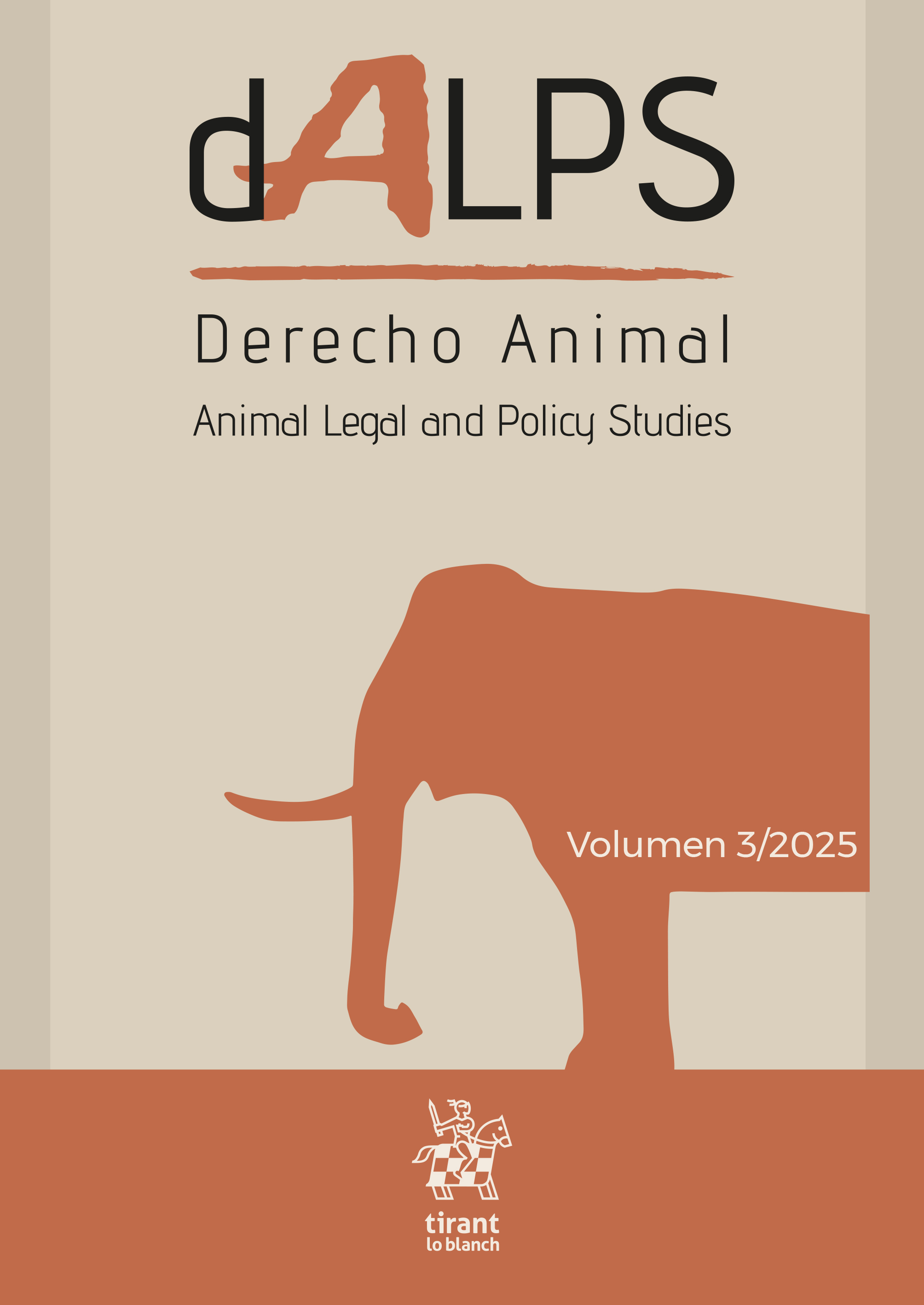Social reproduction crisis of laboratory animals
DOI:
https://doi.org/10.36151/DALPS.058Keywords:
Abolitionism, laboratory animals, social reproduction crisis, value framework, sentient commodity, mediated representationAbstract
This article analyzes the social reproduction crisis of laboratory animals subjected to the vivisection industrial complex. To do so, it adopts a critical perspective from radical anthropology and abolitionism, which allows the interpretation of political economy concepts and the work of social scientists. This approach makes it possible to understand the extraction of value and the instrumentalization of these individuals within the scientific production system by proposing value frameworks. In addition, two new concepts are introduced to help contextualize current animal-related issues. Through a critical lens, the inconsistencies between the legal recognition of animal sentience and their differential treatment-based on their assigned use value between laboratory animals and companion animals-are examined, highlighting the contradictions in Laws 17/2021 and 7/2023. The concealment-representation dialectic in the corporate communication of the aforementioned complex is analyzed through case studies, demonstrating how mediated images legitimize experimentation by aestheticizing captivity and applying Russell and Burch's (1959) third R (refinement), thereby obscuring the inherent suffering of the process. Finally, the article reflects on the role of governments and regulations in perpetuating the animal experimentation model, as well as the economic and political interdependence between the vivisection industrial complex and the animal industrial complex. It concludes that the discursive construction of animal welfare in experimentation is part of a speciesist strategy to perpetuate the exploitation of laboratory animals while ignoring ethical and scientific alternatives.
Downloads
References
ADAMS, C.J. La política sexual de la carne (Madrid 2016)
AGUILAR, M.T. Descartes and the body-machine, en Pensamiento (Madrid), 66/249, (2014) 755-770
ALEXIADES, M. La antropología ambiental: una visión desde el Antropoceno, en SANTAMARINA, B. y BELTRAN, O. (Ed). Antropología Ambiental: Conocimientos y Prácticas Locales a las Puertas del Antropoceno (Barcelona 2018) 17-70. DOI: https://kar.kent.ac.uk/69830/
ALMIRON, N., FERNÁNDEZ, L., RODRIGO-ALSINA, M. Illusory authenticity: Negotiating compassion in animal experimentation discourse. Discourse Studies, 26/2 (2024) 153-172. https://doi.org/10.1177/14614456231219633
ALMIRON, N., KHAZAAL, N. Lobbying Against Compassion: Speciesist Discourse in the Vivisection, in American Behavioral Scientist, 60(3) (2016) 256-275. DOI: 10.1177/0002764215613402
ARLUKE, A. Sacrificial symbolism in animal experimentation: object or pet?, in Anthrozoös, 2/2 (1988) 98–117. https://doi.org/10.2752/089279389787058091
BAUMAN, Z. Modernidad y Holocausto (2016)
BENTHAM, J. Introduction to the Principles of Morals and Legislation (New York 2012)
BOURDIEU, P. Homo academicus (Buenos Aires 2008)
BOURDIEU, P. La dominación masculina (Barcelona 1999)
BRAMBELL, R. Report of theTechnical Committee to Enquire into the Welfare of Animals kept under Intensive Livestock Husbandry Systems. Minister of Agriculture, Fisheries and Food (London 1965) 1-89. https://edepot.wur.nl/134379
CRAGNOLINI, M. B. Virilidad carnívora: el ejercicio de la autoridad sojuzgante frente a lo viviente, en Revista Científica de UCES, 16/1 (2012) 23-29
CRENSHAW, K. Demarginalizing the Intersection of Race and Sex: A Black Feminist Critique of Antidiscrimination Doctrine, Feminist Theory and Antiracist Politics, in University of Chicago Legal Forum 1 (Chicago 1989) 139-167. DOI: http://chicagounbound.uchicago.edu/uclf/vol1989/iss1/8
DERRIDA, J. Seminario La pena de muerte (Madrid 2017)
DESCOLA, P. Par delà nature et culture (Paris 2005)
FRANCIONE, G., CHARLTON, A. Derechos animales: El enfoque abolicionista (Madrid 2018)
FRANCIONE, G. Introduction to Animal Rights: Your Child or the Dog? (Philadelphia 2000)
GALTUNG, J. Violence, peace, and peace research, in Journal of peace research, 6/3, (1969) 167-191. DOI: https://www.jstor.org/stable/422690
GIMÉNEZ-CANDELA, M. Animal, una aproximación biojurídica, en DALPS. Derecho Animal (Animal Legal and Policy Studies), 1 (2023) 10-30. DOI: https://doi.org/10.36151/DALPS.001
GROFF, K. et al. Review of evidence of environmental impacts of animal research and testing, in Environments I/1 (2014). DOI: 10.3390/environments1010014
GRUEN, L. Ethics and animals (Cambridge 2012)
GUILLO, D., HAMILTON, P. What is the Place of Animals in the Social Sciences: The Limits to the Recent Rehabilitation of Animal Agency, in Revue française de sociologie, 1/56 (2015) 135-163. DOI : https://doi.org/10.3917/rfs.561.0135
HARAWAY, D. When species meet. (Minneapolis 2008)
HRIBAL, J. C. Animals, Agency, and Class: Writing the History of Animals from Below, in Human Ecology Review, 14/1 (2007) 101-112. DOI: http://www.jstor.org/stable/24707647
jones, p. Birds’s-Eye Views. Queer Queries About Activism, Animals, And Identity (Springfield 2023)
KOPNINA, H. Beyond multispecies ethnography: Engaging with violence and animal rights in anthropology, in Critique of Anthropology 0/0 (2017) 333-357. https://doi.org/10.1177/0308275X17723973
LE BRETON, D. Antropologia del dolor (Barcelona 1999)
LOW, P. The Cambridge Declaration on Consciousness. Proceedings of the Francis Crick Memorial Conference, Churchill College, Cambridge University, July 7 (Cambridge 2012) 1-2
MBEMBE, A. Necropolítica seguido de Sobre el gobierno privado indirecto (Santa Cruz de Tenerife 2011)
NAROTZKY, S. Grassroots economies: living with austerity in Southern Europe (London 2020)
NAROTZKY, S. Antropología económica (Santa Cruz de Tenerife 2004)
NOSKE, B. Deconstructing the animal image: Toward an anthropology of animals, in Anthrozoös 5/4 (1992) 226–230
PEZZETTA, S. ¿Pueden los animales tener derechos si no pueden contraer obligaciones? Animales sujetos y ciudadanos, en Mutatis Mutandis: Revista Internacional de Filosofía. 20 (2023) 36–46
RUSSELL, W.M.S. y BURCH, R.L. The principles of humane experimental technique (London 1959)
RYDER, R. Speciesism again: The original leaflet, in Critical society, Spring 2 (2010) 1-2. http://www.veganzetta.org/wp-content/uploads/2013/02/Speciesism-Again-the-original-leaflet-Richard-Ryder.pdf
SINGER, P. Liberación animal (Madrid 1999)
STRANGE, C., JENNIFER, S, Eugenics in Canada: A Checkered History, 1850s–1990s, in Alison Bashford, and Philippa Levine (eds), The Oxford Handbook of the History of Eugenics, Oxford Handbooks (2010; online edn, Oxford Academic, 2012) 523-538. https://doi.org/10.1093/oxfordhb/9780195373141.013.0032
TWINE, R. Revealing the 'animal-industrial complex'—A concept & method for Critical Animal Studies?, in Journal for Critical Animal Studies 10/1 (2012) 12-39
VINARDELL, M.P. ¿Existen alternativas a los experimentos con animales?, en Revista de Bioética y Derecho, 51/1 (2021) 81-97
WALD, C., WU, C. Biomedical research. Of mice and women: the bias in animal models, in Science American Association for the Advancement of Science, 327/5973 (2010) 1571–1572. https://doi.org/10.1126/science.327.5973
Directiva 98/58/CE del Consejo de 20 de julio de 1998 relativa a la protección de los animales en las explotaciones ganaderas
Ley 17/2021, de 15 de diciembre, de modificación del Código Civil, la Ley Hipotecaria y la Ley de Enjuiciamiento Civil, sobre el régimen jurídico de los animales. «BOE» núm. 300, de 16 de diciembre de 2021 (BOE-A-2021-20727), p. 154138 páginas 154134 a 154143 (10 págs.). DOI: https://www.boe.es/eli/es/l/2021/12/15/17 (Última consulta: 31 de marzo 2025)
Ley 7/2023, de 28 de marzo, de protección de los derechos y el bienestar de los animales. «BOE» núm. 75, de 29 de marzo de 2023 (BOE-A-2023-7936), páginas 45618 a 45671. DOI: https://www.boe.es/eli/es/l/2023/03/28/7 (Última consulta: 31 de marzo 2025)
Council Directive 86/609/EEC of 24 November 1986 on the approximation of laws, regulations and administrative provisions of the Member States regarding the protection of animals used for experimental and other scientific purposes, in https://eur-lex.europa.eu/legal-content/ES/ALL/?uri=celex%3A31986L0609 (Última consulta: 31 de marzo 2025)
Real Decreto 53/2013, de 1 de febrero, por el que se establecen las normas básicas aplicables para la protección de los animales utilizados en experimentación y otros fines científicos, incluyendo la docencia, y los animales utilizados en investigación clínica veterinaria, de acuerdo con el Real Decreto 1157/2021, de 28 de diciembre, por el que se regulan los medicamentos veterinarios fabricados industrialmente, p.11
Informes y publicaciones. Informes estadísticos anuales del uso de animales en la investigación y docencia. Gobierno de España. Ministerio de Agricultura, Pesca y Alimentación. https://www.mapa.gob.es/es/ganaderia/temas/produccion-y-mercados-ganaderos/bienestanimal/en-la-investigacion/Informes_y_publicaciones.aspx (Última consulta: 31 de marzo 2025)
https://elpais.com/espana/madrid/2022-01-31/el-horror-del-caso-vivotecnia-muertes-con-dolor-personal-sin-capacitacion-y-37000-euros-de-multa.html (Última consulta: 31 de marzo 2025
https://www.lavanguardia.com/vida/20220302/8094867/salvacion-38-beagles-universitat-barcelona-momento.html (Última consulta: 31 de marzo 2025)
https://www.labanimaltour.org/ (Última consulta: 31 de marzo 2025)
https://www.labanimaltour.org/tours/pirbright/#node9 (Última consulta: 31 de marzo 2025)
https://www.understandinganimalresearch.org.uk/resources/image-library/laboratory-beagles-play-with-technician (Última consulta: 31 de marzo 2025)
Downloads
Published
How to Cite
Issue
Section
License
Copyright (c) 2025 DALPS (Derecho Animal-Animal Legal and Policy Studies)

This work is licensed under a Creative Commons Attribution-NonCommercial-NoDerivatives 4.0 International License.









